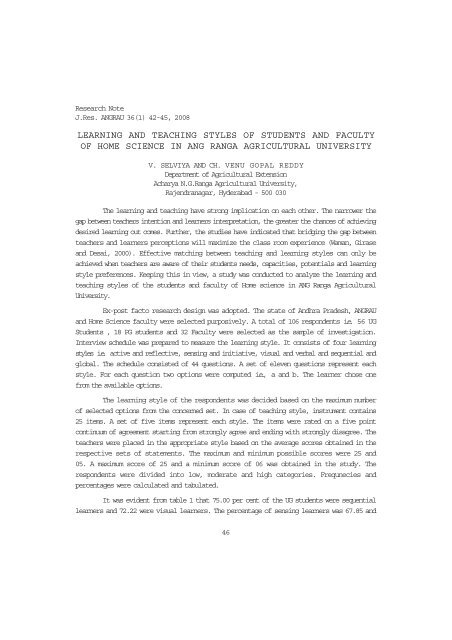The Journal of Research ANGRAU
Contents of 36(1) - acharya ng ranga agricultural university
Contents of 36(1) - acharya ng ranga agricultural university
Create successful ePaper yourself
Turn your PDF publications into a flip-book with our unique Google optimized e-Paper software.
<strong>Research</strong> Note<br />
J.Res. <strong>ANGRAU</strong> 36(1) 42-45, 2008<br />
LEARNING AND TEACHING STYLES OF STUDENTS AND FACULTY<br />
OF HOME SCIENCE IN ANG RANGA AGRICULTURAL UNIVERSITY<br />
V. SELVIYA AND CH. VENU GOPAL REDDY<br />
Department <strong>of</strong> Agricultural Extension<br />
Acharya N.G.Ranga Agricultural University,<br />
Rajendranagar, Hyderabad - 500 030<br />
<strong>The</strong> learning and teaching have strong implication on each other. <strong>The</strong> narrower the<br />
gap between teachers intention and learners interpretation, the greater the chances <strong>of</strong> achieving<br />
desired learning out comes. Further, the studies have indicated that bridging the gap between<br />
teachers and learners perceptions will maximize the class room experience (Waman, Girase<br />
and Desai, 2000). Effective matching between teaching and learning styles can only be<br />
achieved when teachers are aware <strong>of</strong> their students needs, capacities, potentials and learning<br />
style preferences. Keeping this in view, a study was conducted to analyze the learning and<br />
teaching styles <strong>of</strong> the students and faculty <strong>of</strong> Home science in ANG Ranga Agricultural<br />
University.<br />
Ex-post facto research design was adopted. <strong>The</strong> state <strong>of</strong> Andhra Pradesh, <strong>ANGRAU</strong><br />
and Home Science faculty were selected purposively. A total <strong>of</strong> 106 respondents i.e. 56 UG<br />
Students , 18 PG students and 32 Faculty were selected as the sample <strong>of</strong> investigation.<br />
Interview schedule was prepared to measure the learning style. It consists <strong>of</strong> four learning<br />
styles i.e. active and reflective, sensing and initiative, visual and verbal and sequential and<br />
global. <strong>The</strong> schedule consisted <strong>of</strong> 44 questions. A set <strong>of</strong> eleven questions represent each<br />
style. For each question two options were computed i.e., a and b. <strong>The</strong> learner chose one<br />
from the available options.<br />
<strong>The</strong> learning style <strong>of</strong> the respondents was decided based on the maximum number<br />
<strong>of</strong> selected options from the concerned set. In case <strong>of</strong> teaching style, instrument contains<br />
25 items. A set <strong>of</strong> five items represent each style. <strong>The</strong> items were rated on a five point<br />
continuum <strong>of</strong> agreement starting from strongly agree and ending with strongly disagree. <strong>The</strong><br />
teachers were placed in the appropriate style based on the average scores obtained in the<br />
respective sets <strong>of</strong> statements. <strong>The</strong> maximum and minimum possible scores were 25 and<br />
05. A maximum score <strong>of</strong> 25 and a minimum score <strong>of</strong> 06 was obtained in the study. <strong>The</strong><br />
respondents were divided into low, moderate and high categories. Frequnecies and<br />
percentages were calculated and tabulated.<br />
It was evident from table 1 that 75.00 per cent <strong>of</strong> the UG students were sequential<br />
learners and 72.22 were visual learners. <strong>The</strong> percentage <strong>of</strong> sensing learners was 67.85 and<br />
46
















